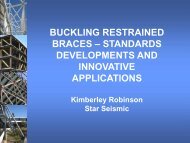Environmental Impacts of Multi-Storey Buildings Using Different ...
Environmental Impacts of Multi-Storey Buildings Using Different ...
Environmental Impacts of Multi-Storey Buildings Using Different ...
Create successful ePaper yourself
Turn your PDF publications into a flip-book with our unique Google optimized e-Paper software.
In comparison the LCA results have shown the following ranking for primary energy use as well asGWP in the reutilisation scenario:1. Timber plus2. Concrete3. Timber4. SteelUnder the re-utilisation scenario GreenStar NZ was unable to differentiate between concrete,timber and timber+ and rated steel as the optimal building material. <strong>Using</strong> energy use and globalwarming potential data LCA assessment <strong>of</strong> the same information showed timber+ as the leastenvironmentally degrading.1.3 Discussion and ConclusionsWhen examining the credits awarded in the self assessments carried out by Scion as describedabove for the different building materials it became evident that individual credits in this particularcase are largely irrelevant. It is more appropriate to measure the percentage contribution <strong>of</strong> thecredits to the final score, taking into account not applicable credits and category weightings. Forexample: 6 credits <strong>of</strong> a possible 24 credits multiplied by the category weighting gives a 2.5%contribution to the final score, but 6 credits <strong>of</strong> a possible 21 credits multiplied by the sameweighting gives a 2.86% contribution to the final score. The percentage contribution to the overallcategory score <strong>of</strong> specific credits allows a more accurate assessment <strong>of</strong> the relative importanceassigned to the selected credits under the GreenStar NZ system and a more meaningfulcomparison with LCA.The GreenStar NZ Office Design V1 tool proved to be <strong>of</strong> limited consistency with respect tocomparisons with life cycle assessment as the basic assumptions <strong>of</strong> the study did not align withthose <strong>of</strong> GreenStar NZ. Under the GreenStar NZ Rating systerm a building will inherently performwell in certain areas and not in others, but good design practice will be rewarded by a balancedscorecard approach for the overall building rating. The assumption in this study <strong>of</strong> consistentperformance <strong>of</strong> the base building in those credits not under comparison does not align with thepremise <strong>of</strong> GreenStar NZ. It is highly unlikely that any base building made from such diversematerials as have been compared in this study would not demonstrate differences in other creditsbeyond materials and energy. This is an academic exercise however and has been reviewed assuch.The study revealed that the level <strong>of</strong> refinement <strong>of</strong> the GreenStar NZ tool was not able to determinea difference between the timber and the timber plus building, both share the same results in theGreen Star NZ assessment. This result could be attributed to a lack <strong>of</strong> volumetric accounting <strong>of</strong>material proposed for construction; the GreenStar NZ-based rating tool used material costs as apercentage <strong>of</strong> the total contract costs. However. in pragmatic terms this was not a significant issuefor this study because the building design assumptions proved to be unrealistic, wherebyconstructing a building <strong>of</strong> the design proposed, in wood alone (timber or timber plus) would not becompliant with building code. The GreenStar NZ tool lacked sufficient refinement to discern theStatus Draft 16.07.2008Project NumberOur Ref − MWH Scion GreenStar Assessment PeerReviewFINAL.doc
















